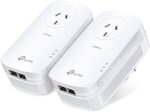Not the cheapest of all time but cheapest in a while and also free shipping on Amazon. AUS plugs
TL-PA9020P Kit
Description:
- HomePlug AV2 standard compliant, high-speed data transfer rates of up to 2000Mbps1, supports all your online needs
- 2X2 MIMO with Beamforming establishes multiple simultaneous connections for you to enjoy higher powerline speeds and greater stability
- 2 gigabit ports create secure wired networks for desktops, smart TVs or games consoles
- Integrated power socket ensures no power outlet goes to waste
edit:
as @theoaus mentioned you can find it on ebay cheaper using the code MCPAY10V3 at $128.80 shipped
https://www.ozbargain.com.au/node/718553 or https://www.ebay.com.au/itm/252768943769
edit2:
new ebay ozbargain post link now at $117.64 shipped using afterpay code AFPAYDAY
https://www.ozbargain.com.au/node/719663 or same ebay link above



 CamelCamelCamel
CamelCamelCamel
